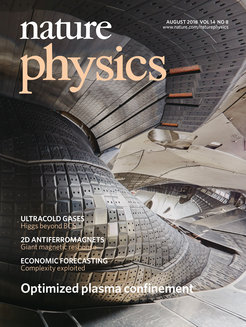Wendelstein 7-X makes the cover
Magnetic configuration effects on the Wendelstein 7-X stellarator / Cover story of Nature Physics 8/18

The accompanying article looks at the results of the first round of experiments with Wendelstein 7-X: Of the two possibilities for confining a fusion plasma magnetically – tokamaks and stellarators – the latter have the advantage of being suitable for continuous operation but the disadvantage of a complicated design. Unlike tokamaks, stellarators do not exhibit rotational symmetry. Their magnetic field must therefore be planned carefully so that it can confine even fast plasma particles effectively. Another problem affecting earlier “classical” stellarators is the so-called “bootstrap current”: Caused by pressure differences in the plasma, this electrical current could deform the specially designed magnetic field and should therefore be as small as possible.
Now, the analysis of measured data from the first round of experiments, carried out from December 2015 to March 2016, has confirmed that both requirements – good particle confinement and a small bootstrap current – have been successfully implemented in the optimized field geometry of Wendelstein 7-X. “The first experimental campaign has therefore already succeeded in verifying key aspects of the optimization,” says the paper’s first author, Dr Andreas Dinklage. “This will be followed by a more precise and systematic evaluation in future experiments with a significantly higher heating power and plasma pressure.”
Publication:
Andreas Dinklage et al.: Magnetic configuration effects on the Wendelstein 7-X stellarator. In: Nature Physics, Volume 14, Issue 8, August 2018 (elektronische Version: 21. Mai 2018)
